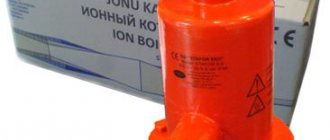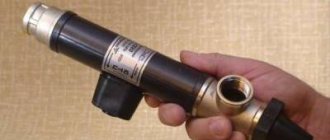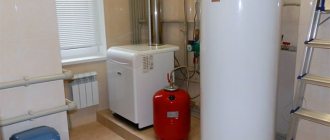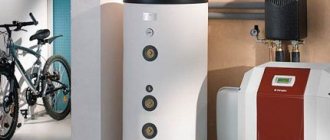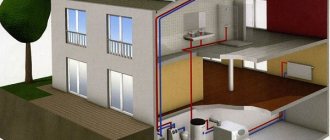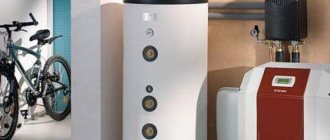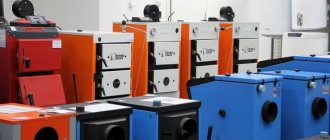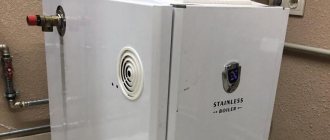When considering a variety of heating system options for a private home, most choose a system with a gas boiler because it is the most economical. However, in addition to the fact that when installing a gas boiler and connecting to the blue fuel supply system for the house, it is necessary that there is a gas pipeline .
So this option is unlikely to be suitable for buildings located at some distance from most communications. In such cases, people often opt for electrode boilers.
Characteristics and operating principle
Electrode boilers are classified as direct heating heating equipment. In this case, the generated heat is sent directly to the energy carrier. This property of the device allows you to significantly increase the power of the unit , since there is no intermediary during heat transfer.
Heating is carried out using electrodes that are immersed in a container where the coolant is located. Electric current is conducted through the liquid with a frequency of fifty Hertz. This frequency eliminates the phenomenon of electrolysis, thus, a layer of scale does not form on the inner walls of the boiler. The process of heating the coolant is carried out almost instantly due to the resistance that arises . Ultra-fast heating allows you to use a small-sized tank to provide heat to your home.
This design feature of the electrode boiler makes it possible to significantly reduce energy costs aimed at maintaining the operation of the heating system.
On average, using such a device allows you to reduce electrical energy costs by about forty percent than if you use another boiler.
The design of the electrode boiler is quite sensitive to the quality of water, so ordinary tap water cannot be used to ensure the operation of the electrode boiler. So you first need to carry out special preparation of this coolant. It is best to use antifreeze , recommended by the manufacturers of this equipment.
It is necessary to note one feature of boilers of this type, namely, after some time the electrodes dissolve. This process is completely natural, but its acceleration or, on the contrary, slowdown depends solely on the intensity of operation of the heating system.
Reviews of household ion-type electric boilers: advantages and disadvantages
| Advantages | Flaws |
| Consistently high efficiency over a long period of time | All elements of the heating system must be purchased separately |
| Low cost, 20-30% lower taking into account all the elements necessary for organizing a heating system and 50-60% lower when comparing the boilers themselves | Mediocre automation, inferior in functionality to heating elements models in the middle price segment and above |
| Absence of any malfunctions due to the simplest and most reliable device | Additional difficulties in operation: choice of coolant and the need for its regular change, limited choice of heating radiators, need for reliable grounding |
| Easy to install | Use exclusively in closed heating systems |
| Most compact sizes | |
| 30-40% faster heating of coolant |
Kinds
The main classifications of heating system equipment such as an electrode boiler are:
- power characteristics (this indicator varies from 2 to 50 kW);
- coolant distribution principle (closed and open);
- number of circuits (there may be one or two);
- power supply method (there are single-phase and three-phase).
It is necessary to choose one or another type of equipment only after carefully studying the conditions in which it will be operated, as well as the characteristics that it must meet.
Rating of the best manufacturers
Many foreign and Russian companies produce ion heaters.
The following manufacturers have the best combination of characteristics:
- Galan is a Russian company offering a wide range of boilers of different capacities. The devices are low cost and reliable. Disadvantages - expensive branded coolant and a stepwise power control system.
- EOU is a Ukrainian brand. The company produces equipment with power from 1 to 36 kW. The declared service life of the products is 30 years. Disadvantages of boilers are high prices, frequent problems with automation.
- “Coterm” is a Russian company engaged in the production of electrical equipment. It produces devices characterized by fast heating of the working fluid, high-quality assembly and compact dimensions. Typical disadvantages are the limited functionality of the automation, the need to fill the heating system with its own Coterm Eco coolant.
- Beril is a Latvian company whose products stand out for their reliability and advanced functionality. The automation system is equipped with several operating modes, degree-by-degree power adjustment, and overheating protection. Provision is made for connecting a GSM module and external temperature sensors. The main disadvantage is the high cost.
- Buderus is a German brand that produces a wide range of gas equipment. The devices are distinguished by their reliability and long service life. Among the electrode models there are two- and three-phase units. The main disadvantage is the price, which is higher than that of Russian devices.
Advantages of using electrode boilers
It is worth noting that all the benefits of using such heating equipment can only be fully appreciated if there is reliable electrical wiring. The supply network itself must always be in a stable state . The fact is that in the event of frequent power outages or constant serious voltage drops, the unit simply will not be able to work for a long time and perform all its functions fully. So it simply doesn’t make sense to install this equipment.
However, even in such a case, you can find a way out of the situation.
For uninterrupted operation of the electrode heating boiler, it is necessary to purchase an additional uninterruptible power supply or diesel generator.
Such equipment allows the boiler to operate for several more hours in the event of a power outage from the power supply network.
The list of advantages of using a diode boiler, compared to other similar equipment, includes:
- High indicator of safety of use . The unit is designed to prevent electrical leakage. So during operation there will be no sparks or other similar troubles that could cause a fire. In addition, this property of the equipment makes it possible to maintain a minimum temperature without constant monitoring.
- Relatively small in size , as well as the ability to be installed in a system previously running on natural gas. You can even create a combined system that will run on gas, but if there is no supply, it switches to operating on electricity.
- Fast heating of the entire heating system , low noise generated during operation of the unit, as well as the ability to replace worn or broken elements of the system without replacing the entire system.
- This equipment can be installed in residential premises without installing a boiler room and chimney. The installation process itself is quite simple and can be done independently. The most important thing is to follow the instructions and safety precautions.
- High efficiency . Its value may well reach 96%, which is quite a lot for heating devices. When heating the system, you can save up to 40% of energy.
- When this boiler operates, there are no combustion products , namely smoke, soot, ash and fumes. This circumstance not only makes the equipment environmentally friendly, but also greatly facilitates its maintenance and increases the service life of the unit.
Ion heating boilers: operating principle
There are situations when using electricity to heat a private home becomes the only option worthy of consideration. Gas pipelines, unfortunately, have not yet reached the level of ramifications to reach everyone. A solid fuel heating system requires constant attention from the owners of the house, a mandatory separate boiler room, and places for storing at least a minimum supply of firewood or briquettes (pellets). Diesel fuel boilers are very expensive in themselves, require large installation costs and precise adjustments, and cannot do without preparing a large container with a volume of several cubic meters for storing liquid fuel.
Ionic heating boilers
So, in such a situation, there is nothing left to do but switch to electric heating of the home. There are many options for solving this problem. For example, these could be “warm floors” using cables, mats or infrared films. Modern heating systems PLEN , which are easy to hide behind the finishing of the ceiling or walls, are gradually gaining appreciation. But still, the usual water heating systems remain in first place in popularity, into which in this case an electric boiler crashes. But here options are also possible - heat sources can be ordinary - with heating elements, induction of various types. And the most controversial, causing considerable, sometimes even heated discussions, are ion heating boilers.
These devices are credited with absolutely fabulous heating efficiency indicators, for example, efficiency above 100%, and are incredibly criticized for the fact that they can usually quickly render the heating system unusable, praised for ease of installation and compactness, and at the same time “ostracized” for its low level electrical safety. As usual, in reality the truth is somewhere in the middle... Let's try to understand this, without bias, citing in the article both the positive qualities of such boilers and their inherent disadvantages. In addition, the most popular brands will be considered, indicating the technical characteristics of various models and approximate price levels. And finally, as the presentation progresses, attention will be paid to some issues regarding the installation of such equipment.
How does an electrode (ionic) heating boiler work?
Probably everyone who has ever lived in a student dormitory or served in the army knows the simplest device for boiling water, which made it possible to brew a cup of tea in literally a matter of seconds. Two metal plates (old razor blades or even metal shoe shoes), spaced with a small air gap from each other, connected to a 220-volt power cord.
The simplest boiler is a kind of “prototype” of an electrode (ion) heating boiler
Such a “device”, lowered into a glass and connected to power, ensures a rapid, unusually violent boiling of water. And this is a fairly clear example of how an ion (or electrode) boiler is designed in principle.
(By the way, you should not repeat such experiments at home - this is unsafe both from the point of view of a wire fire from a short circuit and from a high probability of getting an electrical injury).
Conductors placed in an electrolyte solution (and ordinary, non-distilled water is, to a certain extent, an electrolyte due to the salts dissolved in it), when voltage is applied to them, they cause ionization of the solution and the movement of ions in the opposite direction: anions - to cathode and cations, respectively, to the anode.
The anode and cathode change places 50 times per second
This would lead to the electrolysis process if the supplied current were constant. But when connecting to household mains voltage, the polarity of the electrodes changes 50 times per second (frequency 50 Hz). Instead of a uniform movement of ions, they begin to oscillate rapidly in a medium that offers considerable resistance to this. As a result, very rapid heating of the liquid occurs - that is, the coolant, which is used to transfer energy through heat exchange points.
By and large, the developers of such a scheme managed to get rid of the “middleman” - a heat-generating electric coil made of materials with high resistivity. The role of the heating element is assumed by the coolant-electrolyte itself. This is what is attributed to the special properties of efficiency and economy of this method of converting electrical energy into heat.
Immediately, perhaps, some clarity should be brought about the terminology used. In various sources you can find the name of this technique as both “electrode” and “ionic” boilers. Moreover, some manufacturers even try to make a distinction between these concepts - they say that in ion installations it is possible to to a certain extent control and regulate the number of ions involved in the process of heating the coolant. Understanding heating specialists regard such statements as nothing more than a marketing ploy to highlight their products against the general background. But even if this is true to some extent, the merit lies not in the design of the boiler, but in the complexity of the electronics of the control unit and the quality of the coolant electrolyte. And the boiler itself was and remains electrode.
General structure of an ion (electrode) boiler
This method of quickly heating a liquid is certainly not some kind of innovative development. As a physical phenomenon, this has been known for a very long time, and its practical application in order to obtain thermal energy for space heating was mastered in the middle of the 20th century. It is generally accepted that the first detailed boilers were developed for the needs of the navy, or more precisely, for heating the compartments of submarines. And one of the requirements for any military equipment of those years was maximum simplicity and the highest reliability. Ion boilers fully met these requirements. There are absolutely no moving mechanical parts in them, and the internal “electrical equipment” is such that there is simply nothing to burn out in it. And the active service life of such a water heater, in fact, was determined by the strength and corrosion resistance of its body.
However, it was only in the early 90s that boilers for use in heating systems of residential buildings were developed, patented and put into production. By the way, despite the fact that a quarter of a century has passed since then, neither the layout diagram nor the appearance of these devices have undergone major changes. All improvements to this equipment are made, for the most part, in the area of modernization of control systems, to some extent - in the selection of the most optimal, resistant materials for the housing and electrodes and in the chemical composition of coolants.
Despite the fact that similar boilers are produced by several companies, domestic and foreign, they are all basically similar in layout and differ only in minor details.
The layout of almost all electrode boilers is very similar - a vertically located cylinder with a thickening at the power connection point
It is always a vertically located cylinder, with a thickening on one edge - there is an electrical switching unit. There are always two threaded pipes - for the coolant inlet (in the terminology of heating systems - “return”) and for the outlet of the heated liquid (supply pipe). More often they are located as shown in the figure - the “return” pipe is on the side of the cylinder, and the outlet is on top. Although, occasionally there are models in which both threaded pipes for insertion into the system are located on the side.
Electrodes are located inside the housing.
Electrode for single-phase boiler
If the boiler is designed to operate from a single-phase 220 V network, then this is one electrode, which will be located in the center of the cylinder. The role of the second in this case will be played by the inner surface of the “glass” in the body.
More powerful boilers use three-phase electrodes
Three-phase boilers are more powerful. Here the electrode block will consist of three rod elements isolated from each other, also located in the common “glass” of the boiler body.
It is clear that the electrode block has a reliable sealing system that prevents the electrolyte (coolant) from leaking out. Reliable electrical insulation is provided for the contact part and the outer surface of the boiler body itself - for this purpose it is covered with a layer of polyamide.
Low power boilers can be quite miniature
The dimensions of the boiler are usually not too large - this depends on its total power and on the specific model. This will be discussed in more detail in the section on the main manufacturers of such equipment.
Most often, there are no longer any control or adjustment devices on the body of the boiler itself. But every boiler must be equipped with an electronic or electromechanical control unit of varying degrees of complexity.
One of the thermostat block options
These control units allow the boiler to be turned on only to maintain the set heating mode. Thus, the system can be equipped with one temperature sensor (on the heated coolant supply pipe) or even two (an additional one on the return pipe). The maximum heating temperature and its hysteresis are set on the control unit (Δt°, that is, the difference in temperature values in both directions, at which a control signal is generated to turn the boiler power on or off).
Electrode boiler equipped with sensor and regulators
In some control systems that can be more finely tuned, it is possible to set the nominal temperature value in the “return” and the hysteresis value for it. There are also more “sophisticated” control schemes that are typical for certain equipment manufacturers.
About the advantages and disadvantages of ion (electrode) boilers
Much has been written about the advantages of electrode boilers and, often, contradictory. Let's look at it in order:
Advantages - truth and speculation
- Electrode boilers have the highest efficiency, close to 100%. This is the honest truth, but with some reservations.
By the way, you can come across publications that claim that the efficiency even exceeds this threshold - 100%. More precisely, it says that the coefficient is 30 - 40% higher than that of conventional boilers with heating elements. There is no way to believe this.
Indeed, any electric boilers have a high efficiency, tending to 100%, no matter what heating principle is used: resistive (heating element), induction or ionic - almost all electrical energy is converted into heat and is ultimately transferred to the coolant. The only question is how quickly the boiler reaches the design heating temperature - at the start-up stage, a boiler with heating elements, of course, will require a little more time. And so, no one has canceled the law of conservation of energy, and one cannot expect any miracles from an electrode boiler.
- With equal heating power, electrode boilers are the most compact and lightest in weight among their “brothers”. It's hard to disagree - this is true. They are especially noticeably superior to induction heaters, which are always distinguished by their massiveness and overall dimensions.
- An electrode boiler does not require the installation of a chimney system - like any other boiler powered by electrical energy.
- There is absolutely no possibility of overheating and failure due to coolant leakage from the system. Indeed, an important advantage: the electrodes do not contact each other in any way, and the lack of liquid leads to a complete open circuit - the boiler, by definition, cannot operate in such conditions.
- Heating of water occurs very quickly, which, according to the laws of thermodynamics, is accompanied by a sharp increase in pressure in the system. It is possible to do without a circulation pump.
It would seem that everything is correct, but for some reason such systems are still not used without a pump. Firstly, it is completely unproductive to direct part of the energy to ensure circulation (with a pump, consumption for these purposes will be lower, and the process will be more controlled). And, secondly, we can talk about such a powerful pressure surge only when the system is starting up. In the future, when the control switches to maintaining the temperature within the established hysteresis, this process will not differ in any way from all other boilers.
- The inertia of such a boiler is the smallest of all electric varieties. Therefore, there is the possibility of very precise and rapid operation settings that will help save on energy costs.
A classic example of how two completely unrelated statements are collected in one expression. Indeed, inertia is low. First of all, due to the fact that the mass of the boiler itself is insignificant, and heating of the liquid begins faster. Regarding energy costs - they, at the same time, as we have already found out, efficiency depend, rather, on the level of thermal insulation of the building, that is, on the existing heat losses. But the efficiency of switching and the accuracy of settings is unlikely to have any tangible effect on both the comfort of living and efficiency. Is it possible that such a boiler will turn on and off more often, which, by the way, is not even particularly good.
As for the accuracy of the settings, this is still a very controversial issue. If we take into account the nonlinearity of the electrolysis heating process and the special requirements for the quality of the electrolyte, then perhaps controlling a conventional boiler looks like a much simpler task.
- Voltage drops do not affect the operation of the boiler - its power may only change, but operation will not stop.
The boiler may not be afraid of voltage surges, but they are absolutely not needed for the control electronics.
Reading about such an “advantage” is even somewhat funny. By and large, neither ordinary boilers nor heating elements are afraid of voltage drops. But complex automation, which regulates and directs the operation of any boilers, requires a certain stability of power supply. And electrode boilers are no different from others in this regard.
- Electrode boilers can be installed in the heating circuit as additional energy sources.
Indeed, it is possible, but in this case you will have to bring the state of the coolant to the one that is required specifically for an electrode (ion) boiler.
A very “solid” battery of electrode boilers!
It is also possible to install several boilers in parallel with the same power - in this case it will be possible to stepwise adjust the total heating power - by turning on all or a selected number of heaters.
- The operation of electrode boilers is absolutely harmless from an environmental point of view.
Waste coolant necessarily requires proper disposal.
The issue is controversial. Yes, there are not and cannot be any harmful emissions into the atmosphere - but this is typical for all electric heaters. But due to the composition of the coolant, electrode boilers can even pose a certain environmental hazard. Often it contains very toxic substances (such as ethylene glycol), and the spent electrolyte, if replaced quite often, requires a special disposal procedure - simply pouring it onto the ground or even into the sewer system is strictly prohibited.
- The cost of electrode boilers, compared to other electric ones, is the lowest.
This is indeed true, but one cannot help but notice one “marketing trap”. Very often the cost of such boilers is indicated without taking into account the price of automation units. Conventional boilers with heating elements, as a rule, are assembled in one housing with all the built-in electronics, temperature sensors, thermostat, etc., so their price is appropriate.
The cost of control equipment must also be taken into account immediately, since without it all the advantages of electrode boilers are literally reduced to zero - uncontrolled heating of the liquid will not only be uneconomical, but also extremely dangerous!
Disadvantages of ion boilers
Honestly, if you just look at the list of disadvantages of electrode boilers, then any desire to get involved with this type of heating disappears. However, let the reader judge for himself, since some of the “cons” are clearly far-fetched and do not deserve special attention.
- Sometimes the disadvantages include the fact that the electrode stake requires only alternating current - with constant current, the process of electrolysis of the coolant will begin with its chemical decomposition.
Considering this a drawback is the same as complaining that a car does not want to run on alcohol, and a home TV refuses to work on a AA battery. Each device has its own capabilities and its own energy sources, and this has nothing to do with disadvantages.
- The need to equip the heating circuit with a circulation pump.
This has already been mentioned above, but such a “disadvantage” is inherent in almost all home heating systems, with the exception of open ones with natural circulation. And even then, it is also recommended to install pumps in them - this affects the uniformity and overall efficiency of heating the home.
- Special requirements for the quality and chemical composition of the coolant.
Here, you can’t argue; indeed, the electrode boiler will not work with any liquid that gets into it. Several criteria must be combined here - the possibility of ionization (for example, distilled water will not work in principle), relatively low electrical resistance (if the value is high, the current simply will not flow through the liquid). And at the same time, we must not forget about the general requirements for any coolant - high heat capacity, resistance to freezing, operating temperature range, environmental friendliness, etc.
Many manufacturers of electrode boilers directly give recommendations on the use of specific brands of coolants, which they often produce themselves. Moreover, there are cases where warranty service for equipment was refused due to violations of recommendations.
Most boiler manufacturers also produce the corresponding coolant for them
Many craftsmen are very critical of factory-made compounds and recommend using saline solutions (brines) made independently. But independently selecting the optimal composition, without special equipment for testing electrical conductivity, is an extremely difficult task. This approach is complicated by the fact that over time the electrical characteristics of the coolant can change significantly, and in addition, they largely depend on the current heating temperature.
In a word, selecting the right coolant for the system in the case of electrode boilers turns into a very troublesome task. And if we also take into account that replacement of the entire volume of working fluid will have to be carried out before each heating season...
- Not all heating radiators can be used in conjunction with electrode boilers.
The honest truth is that for such a heating system, either bimetallic or aluminum radiators are recommended. Moreover, when choosing aluminum, you should also pay attention to the quality of the material - is it a primary metal, or a processed product. The fact is that the processed metal will necessarily contain a large number of impurities - oxides, and they can very seriously disrupt the chemical composition of the electrolyte, sharply increasing or decreasing the electrical conductivity, which will unbalance the operation of the system.
Cast iron radiators are very undesirable for two reasons. Firstly, their very significant heat capacity can exceed the normal heating capabilities of an electrode boiler, and it will work almost non-stop. And secondly, old cast iron batteries, as a rule, are not distinguished by internal cleanliness, they lend themselves to really high-quality cleaning due to the porosity of the surface, and can quickly render the coolant unusable for operation. And no one has canceled the corrosion of ferrous metals, and any electrolyte is always characterized by increased corrosion properties.
Modern cast iron radiators can, with some reservations, be used in systems with electrode boilers
As an exception, modern cast iron radiators made in Europe may be suitable. They have a smaller volume and a higher quality of metal.
- Electrode boilers have particularly increased requirements for grounding.
By and large, any powerful electrical installations must have reliable grounding of the frame. But if in most cases this is a means of protection against accidental breakdown of a phase on the housing, then in the example with ion boilers everything is more serious. Their metal body is directly involved in the work process, and therefore, indeed, grounding becomes of utmost importance for ensuring safety. Moreover, the standard RCD unit is not applicable in the case under consideration, since there will be a voltage leak one way or another, and the power with such protection will be constantly forcibly turned off.
How to properly make grounding in your own home can be found by following the link to the corresponding article on our portal.
- There are strict restrictions on the maximum heating temperature - up to 75 degrees.
This is, rather, not a drawback, but a feature of the operation of such a heating circuit. The fact is that the electrical conductivity of a liquid changes nonlinearly, and at temperatures above 75 ° C there may be unnecessary waste of energy without increasing power. However, this temperature should almost always be enough for high-quality heating. And the upper heating limit, by the way, exists for any boilers (including gas and solid fuel) and this must be monitored by automation.
- The electrodes become overgrown quite quickly, due to the specific nature of the work, and require regular replacement. This is also probably not a disadvantage, but operating costs - any equipment eventually requires replacement of consumable parts.
- It is impossible (in any case, extremely undesirable) to use such a boiler in an open-type heating system.
This is true - the electrolyte itself is a rather aggressive environment for the elements of the heating system. If air oxygen still has free access to the coolant, its ability to cause corrosion will increase many times over, but the necessary chemical composition to ensure the required electrical conductivity may change for the worse.
- It is inadmissible to use heated water for domestic and technical needs (with a single-circuit heating system). This drawback can be eliminated by installing an indirect heating boiler, of course, having correctly calculated the overall capabilities of the system.
- Very big difficulties when starting the heating system.
We are not talking about the installation of the boiler itself, its installation and piping - here experienced craftsmen should not have any special problems. The main problems, as already mentioned, are the correct selection of the chemical composition of the coolant and fine adjustment of the system. It is not recommended to carry out such activities on your own; you will need to invite experienced specialists.
The same can be said about regular preventive measures in preparation for the heating season, since it is almost impossible to correctly assess the condition of the coolant and the overall performance of the system without gained experience and without special equipment. This means that you will have to put up with the annual call of the relevant specialists.
Find out how to make an electrode boiler with your own hands, and also read the detailed instructions in the article on our portal.
Electrode (ion) heating boilers on the Russian market
Thanks to their advantages, and despite their rather numerous disadvantages, ionic heating colas remain very popular in the Russian open spaces. Several domestic companies are engaged in their production, and products are also supplied from foreign countries. To help the reader with the choice of equipment, a brief overview of the most popular brands will be given
Galan electrode boilers
Moscow products, without a doubt, are pioneers in the domestic market for equipment of this type, and it is possible that throughout the world too. Their production was mastered in the early 90s on the basis of our own patented development. There are no exact statistics, but, most likely, “Galan” still holds the “palm” in this area; in any case, these boilers are definitely the leaders in terms of mentions on the Internet and positive reviews.
Model range of electrode boilers "Galan"
Today the company produces three main models, each of which has several gradations in terms of heating power level.
The smallest ones are “Galan-Ochag”. Weighing only 500 g, these “babies” are capable of efficiently heating quite large volumes - up to 200 m³, delivering power up to 5 kW. The cost of such boilers is from 3300 to 4000 rubles. A more modern model - "Galan-Ochag-Turbo" can be slightly more expensive - up to 6,000 rubles.
In private residential construction, the most popular are single-phase and three-phase electrode boilers "Galan-Geyser". They have two heating power thresholds - 9 and 15 kW, and this should be enough for a completely respectable country cottage with a total volume of sealed rooms of up to 450 m³. The average cost of such boilers is 6 to 7 thousand, and “Geyser-Turbo” is about 8 thousand rubles.
The most powerful are the electrode colas in the Galan-Vulcan line. They are all designed to operate in a three-phase network, have a power of 25 and 50 kW, and are intended for heating fairly large structures. The price for them is over 10 thousand rubles.
| Basic parameters of electric heating boilers | VULCANO 50 | VULCANO 25 | GEYSER 15 | GEYSER 9 | HEATH 6 | HEATH 5 | HEATH 3 |
| Consumption voltage, V | 380 | 380 | 380 | 220/380 | 220 | 220 | 220 |
| Heated room, m³ | up to 1600 | up to 850 | up to 550 | up to 340 | up to 250 up to 200 | up to 120 | |
| Coolant volume, liter | 300-500 | 150- 300 | 100- 200 | 50-100 | 35-70 | 30-60 | 25-50 |
| Current consumption, max, A | 2×37,9 | 37.5 | 22.7 | 13,7/40 | 27.3 | 22.7 | 13.7 |
| Peak power consumption in kW, at water temperature 90ºС | 50 | 25 | 15 | 9 | 6 | 5 | 3 |
| Power consumption in kW, on average for the heating season (6 months - 4320 hours) from October 15 to April 15. | up to 36000 kW | up to 18000 kW | up to 12000 kW | up to 8000 kW | up to 6000 kW | up to 5000 kW | up to 3000 kW |
| Recommended outlet temperature, °C | 60 | 60 | 60 | 60 | 60 | 60 | 60 |
| Coupling diameter for connecting the boiler to the heating system | 32 | 32 | 32 | 32 | 25 | 25 | 25 |
| weight. kg | 11.5 | 42130 | 42130 | 42130 | 0.5 | 0.5 | 0.5 |
| diameter, mm | 130 | 130 | 130 | 130 | 35 | 35 | 35 |
| length, mm | 570 | 460 | 410 | 360 | 335 | 320 | 275 |
If the basic models of Galan boilers themselves remain practically unchanged, then the control automation is constantly being improved. Thus, for modern household-grade boilers, it is recommended to purchase Galan-Navigator control units in various designs (price - from 6 thousand).
Basic control unit "Galan - Navigator"
There may be other proposals - for example, equipping the Galan boiler with an ABB or Hager circuit breaker, a modular digital coolant thermostat "BeeRT", which will simultaneously regulate the performance of the circulation pump, and a room thermostat "by air" COMPUTHERM Q7". Such a system is fully agreed with the boiler manufacturer, but its cost, of course, will be somewhat higher.
Video: variety of Galan boilers
Prices for the Galan heating boiler range
Heating boilers Galan
Ion heating boilers "Beryl"
Another popular Russian product is the Beryl family of electrode heating boilers.
They are produced in two sizes, depending on the power supply network used - 220 or 380 volts, and on the installation power, respectively - up to 9 and up to 33 kW.
Single-phase electrode boilers "Beryl"
Dimensions of the three-phase modification "Beryl"
A characteristic feature of all Beryl boilers is the top location of the power connection unit - this somewhat simplifies both installation and maintenance. Even to replace the electrode block, in most cases it will not be necessary to dismantle the entire boiler from its piping.
| Name of boilers, control systems: | price, rub. |
| BERIL ion boilers and automation (manual power change, step 200 (600) W) | |
| Boilers 220V; 5, 7, 9 kW | 4450 |
| Boilers 380V; 6, 9, 12, 15, 25, 33 kW | 8450 |
| Control unit "Euro" for boilers 220V and 380V | 14000 |
| BERIL ion boilers and automation (automatic / manual power change, step 600 W) | |
| 380V boilers with triac unit 6, 9, 12, 15, 25, 33 kW | 20000 |
| CSU control unit (with PID mode function) | 15000 |
| BERIL ion boilers and automation (automatic / manual power change, step 2000 W) | |
| Boiler 380V with built-in triac unit, 100 kW | 75000 |
| Boiler 380V with built-in triac unit, 130 kW | 100000 |
| CSU control unit (with PID mode function) for 100 and 130 kW boilers | 25000 |
| Electrode boilers BERIL and automation | |
| Boilers 220V; 5, 7, 9 kW | 4450 |
| Boilers 380V; 6, 9, 12, 15, 25, 33 kW | 8450 |
| Control unit ETsRT GEKK for boilers 220 and 380 V | 8500 |
| BERIL thermal modules of unlimited power with one control unit | |
| Boilers 380V 33 kW with triac unit - 1 pc. | 20000 |
| Control unit GEKK 63/3M TsSU for module operation in PID mode | 20000 |
| Control unit GEKK 60/3 TsSU for operation of the module in group control mode | 25000 |
| BERIL VIP coolant based on propylene glycol | |
| temperature -35C (-45C crystallization temperature) polye canister 20 liters | 2200 |
By the way, it is some models of Beryl boilers that are positioned as ionic boilers - because, according to the manufacturer, they implement the ability to control the overall level of electrical charges. Such products can be equipped with control units of varying complexity:
Control unit for boilers "Beryl" CSU "Euro"
TsSU "Euro" control units allow you to manually adjust the heating power of the coolant in steps of 200 W.
1 – connection block (power contactor);
2 – step boiler power regulator;
3 – automatic overload protection;
4 – thermostat control unit, according to the coolant heating level.
Beryl ion boiler with triac unit
More expensive models, with automatic control and regulation of power at each specific moment in time, are equipped with a special triac unit (pictured) and a PID system - electronic temperature control. It is believed that the PID controller, which consists of an amplifier, integrator and differentiator, most quickly and accurately estimates the heating level taking into account the immediate future and generates control signals that allow saving up to 20% of energy.
Line of boilers EOU (Energy Saving Heating Installation)
This is also a Russian-made product. Simple in design, relatively inexpensive, but quite easy to use, the boilers cover a power range from 2 to 120 kW. They can be produced for single- and three-phase current networks, differing in size.
Dimensions of electrode boilers "EOU"
Such boilers are popular not only in our country, but also in neighboring countries, and last year the products received certification from the Customs Union.
These boilers have been certified by the Customs Union
The table shows technical data and the average price level for boilers operating on a 220 volt network, as the most popular in domestic conditions:
| Technical data | Unit | Single-phase modifications | |||||||||
| 1/2 | 1/3 | 1/4 | 1/5 | 1/6 | 1/7 | 1/8 | 1/9 | 1/10 | 1/12 | ||
| Operating voltage | Volt | ~220 | ~220 | ~220 | ~220 | ~220 | ~220 | ~220 | ~220 | ~220 | ~220 |
| Power consumption | kW | 2 | 3 | 4 | 5 | 6 | 7 | 8 | 9 | 10 | 12 |
| Heated room volume | m³ | 120 | 180 | 240 | 300 | 360 | 420 | 480 | 540 | 600 | 750 |
| Heated area | m² | 40 | 60 | 80 | 100 | 120 | 140 | 160 | 180 | 200 | 250 |
| Electricity consumption per day | kW | 2-16 | 3-24 | 4-32 | 5-40 | 6-48 | 7-56 | 8-64 | 9-72 | 10-80 | 12-96 |
| Raising water in a water system (without pump) | m | 3 | 4 | 5 | 6 | 7 | 8 | 9 | 10 | 11 | 13 |
| Weight, no more | kg | 3 | |||||||||
| Price of the device, without control panel | rub. | 4200 | 4300 | 4400 | 4500 | 4600 | 4700 | 4800 | 4900 | 5000 | 5100 |
| Price of a set of components for the control panel | rub. | 1410 | 1990 | 1990 | 1850 | 1850 | 1850 | 2540 | 2540 | 2540 | 2540 |
Despite the unpretentious design of EOU boilers, the manufacturer gives them a factory warranty of at least 10 years, and the total service life is estimated at 30 years.
Video: examples of using EOU electrode boilers
Imported electrode boilers
In addition to Russian-made boilers, models produced in some neighboring countries are in demand.
Ukrainian-designed and produced Forsazh boilers are interesting in that they are equipped with a special casing - a casing, which increases the operational safety of the installation and still makes its appearance more attractive.
Boiler "Fast and Furious" in the box
The line of Forsazh boilers is represented by five models operating from 220 V, with a power from 3 to 25 kW. All of them are equipped with a control unit of our own design - an electronic digital temperature controller (EDRT).
Set - “Forsazh” boiler with electronic digital temperature controller
The basic characteristics of Forsazh electrode boilers are given in the table:
| Parameter name | Execution options | ||||
| FAST AND THE FURIOUS 3 | FAST AND THE FURIOUS 5 | FAST AND THE FURIOUS 9 | FAST AND THE FURIOUS 15 | FAST & FURIOUS 25 | |
| Rated voltage, V | 220 | ||||
| Permissible deviations from the rated voltage, % | ±10 | ||||
| Rated frequency, Hz | 50 | ||||
| Rated current in one phase at a coolant temperature of 63°C, A | 13.6 | 22.7 | 13.6 | 22.7 | 37.9 |
| Rated power consumption, kW | 3 | 5 | 9 | 15 | 25 |
| Electronic digital temperature controller (EDCRT) | ECRT-3 | ECRT-5 | ECRT-9 | ECRT-15 | ECRT-25 |
| Coolant | Special coolant "Forsazh-M" | ||||
| Coolant volume in the heating system, l | 20 — 40 | 30 — 60 | 60 — 120 | 100 — 200 | 160 — 300 |
| Coolant operating pressure (cold) | 0,1 — 0,15 | ||||
| in the heating system, MPa (bar) | (1 — 1,5) | ||||
| Maximum permissible pressure, MPa (bar) | 0,3 (3) | ||||
| Maximum volume of heated premises, m 3 | 100 | 170 | 300 | 450 | 750 |
| Overall dimensions, mm | 265x135x88 | 470x190x136 | |||
| Nozzle diameter | 1,25″ | ||||
| Weight, kg | 1.85 | 1.95 | 6.05 | 6.4 | 6.85 |
| Execution according to the degree of protection against moisture | IPX3 | ||||
And finally, we can mention a device developed and assembled in Latvia – the STAFOR boiler. It is interesting for several innovative solutions, including the use of a “Faraday cage” - separation of the protective and working zero.
STAFOR electrode boiler with automation kit
Of all the boilers, it has the highest safety indicators, and is the only one of its kind - it has passed full certification according to the very strict requirements of the European Union. This boiler is fully equipped with its own electronics. In addition, with it you can purchase not only a branded coolant, but even a special additive, STATERM POWER, which allows you to timely adjust the chemical composition of the electrolyte to adjust the boiler power.
So, the principle of operation, advantages and disadvantages of such heating boilers are clear to the reader. He is familiar with the variety of models and approximate price levels. All that remains is to make your own choice - “for” or “against”.
Flaws
Equipment for a heating system that is ideal in all respects simply does not exist. So electrode boilers also have a number of disadvantages that must be taken into account when selecting, installing and subsequent operation.
The disadvantages of such a unit include the rather high cost of electricity.
However, if this equipment is not in constant use, but, for example, is used from time to time, or if necessary (for example, only in winter), and also in cases where the house is located at some distance from most communications, then this drawback is not significant .
Another nuance that can be called a disadvantage is that electrode devices are very difficult, if not impossible, to combine with some types of radiators and pipelines. An example of this is the combination of an electrode boiler and cast iron batteries. These radiators are characterized by a rather large volume, so they need to heat a lot of water, and an uneven inner surface. Problems can also arise if metal-plastic pipes and an electrode boiler are found in the same heating system. In this case, it is better to replace the pipes with polypropylene ones.
Another disadvantage is the need to maintain a constant coolant resistance. This can be done by adding special additives that prevent scale formation.
Installation and operation
When installing an electrode boiler, the main condition is the presence of working automatic air vents, a pressure gauge and a safety valve. The shut-off valves should be located near the expansion tank.
When installing, make sure that the tank is in a vertical position. In this case, the first 1.2 m of pipe must be made of metal, but the rest can be made of any material.
It is best not to install climate control and thermoregulation system sensors yourself, but to entrust this work to specialists.
Galan boiler series
Today the company has launched the production of several series of heating devices. As evidenced by user comments, boilers of each model range have their own pros and cons. The basic rule is the correct choice of boiler based on operating conditions. This way you can eliminate many problems.
Hearth
Electric electrode boiler Hearth
The series includes models with powers of 2, 3, 5 and 6 kW. These are low-power devices for heating small rooms with a volume of about 80-250 m³. The volume of coolant in the heating system can be 20-70 liters.
These are compact boilers. The length of the devices is from 25 to 33.5 cm, the diameter is 35 cm. The weight of the structures is about a kilogram. Operation occurs from a 220 W power supply.
Geyser
Electric electrode boiler Geyser
The model range of this series is small - only two types: Geyser-6 and Geyser-9. The boilers are designed for heating areas with a volume of 250 to 340 m³. With high-quality thermal insulation, use 2-4 kW per hour. Weight – five kilograms. The required coolant volume is from 50 to 200 liters.
Volcano
Electric electrode boiler Vulcan-Turbo
This unit is the largest among the entire product range of the company. These devices weigh almost 6 kg and have a power of 25 kW. Operation occurs from a 380 W power supply. The unit will be able to heat an area of up to 850 m³.
Reviews
“I decided to heat my house with electricity, solid fuel is too much of a hassle, and there is no way to connect to gas. Electrode boilers seemed like a way out to me. Unfortunately, they only seemed so. It is necessary to constantly monitor the condition of the water in the system, which is an almost impossible task with constant electrolysis and corrosion. After suffering for a couple of years, I switched to a boiler that runs on solid fuel.” Andrey, Yaroslavl.
“I installed a dacha for heating, where, after retiring, I began to live all year round. My house is insulated, in a good location, not blown by all the winds, so my boiler does not work continuously. I turn on the electrode boiler as needed. Everything suits me. True, I have already cleaned the tank of scale. But nothing is perfect." Olga, Moscow.
“We installed it at a dacha, which is very far from the city. We heat in early spring and don’t live there in late autumn in winter. Everyone is happy. It’s a little expensive, of course, since we get electricity from a diesel generator, but it’s not much more expensive than firewood and coal, and there are a lot fewer problems.” Vitor, Kaluga.
“The old stove has completely collapsed, and I’m no longer able to constantly tinker with firewood and shovel out the ash. It’s too expensive to connect to gas, so we decided to switch to electric heating at home. We chose an electrode boiler. Not to say that we haven't taken care of heating since then. It is necessary to constantly monitor the condition of the water that has to be purified and where antifreeze needs to be added. However, this is still better than chopping wood and cleaning the ceiling from soot.” Ivan, Syzran.
“I read the manufacturers’ recommendations and decided to purchase such a boiler for my home. Installing a table is not expensive, operation also had its own nuances. And electricity is quite expensive, it burned up especially a lot in cold weather, even insulating all the walls of the house didn’t help much.” Arseny, Tver.
